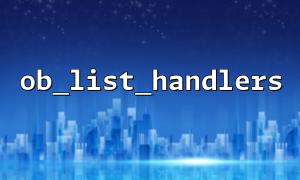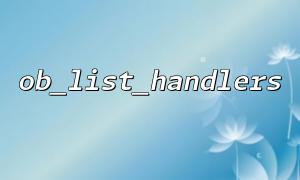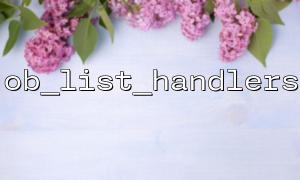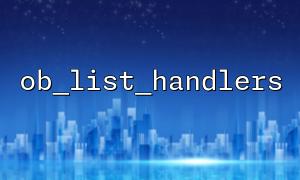In PHP programming, output buffers are a very powerful feature. Using the output buffer, you can temporarily capture the output content, perform operations or modify before outputting. PHP provides functions such as ob_list_handlers() and ob_clean() to help us control the output more carefully. This article will explain how to use these two functions for output control in combination and give examples of their practical applications.
The output buffer allows you to control the page output before generating it. By default, PHP will send the output of the script directly to the browser, but if the output buffer is turned on, the output content will be stored in the buffer first. You can control when to output content and whether to clear the content of the buffer through some functions.
ob_list_handlers() and ob_clean() are common functions for processing output buffers, which are used to list the currently activated output buffer handler and clear the contents of the output buffer respectively.
The ob_list_handlers() function is used to list all current output buffer handlers. It returns an array containing the names of all handlers in the current output buffer stack. You can check if there are currently active output buffer handlers by calling this function, and their order.
array ob_list_handlers ( void )
Returns an array of names of all current output buffer handlers. If no handlers are activated, an empty array is returned.
<?php
// Turn on the output buffer
ob_start();
// Add a custom buffer handler
function custom_output_handler($buffer) {
return strtoupper($buffer); // Convert output to uppercase
}
ob_start("custom_output_handler");
// Output some content
echo "hello world";
// List the current output buffer handler
$handlers = ob_list_handlers();
print_r($handlers);
// Clean the buffer and end
ob_end_clean();
?>
In this example, we first enable the output buffer through ob_start() . Next, we use ob_start() to add a custom buffer handler custom_output_handler to the buffer. Then, the handler name of the current buffer is listed through ob_list_handlers() , and the returned array will contain custom_output_handler .
The ob_clean() function is used to clear the contents in the output buffer, but it does not close the output buffer. Even if the buffer is cleared, the output buffer is still on, and you can continue to use it to capture subsequent output.
bool ob_clean ( void )
Returns true on success, and false if the buffer is empty.
<?php
// Turn on the output buffer
ob_start();
// Output some content
echo "This is some content.";
// Clear the buffer
ob_clean();
// Try to output content again
echo "This is the new content.";
// The contents of the output buffer
$content = ob_get_contents();
echo $content; // Output:This is the new content.
ob_end_clean();
?>
In this example, we first output some content, but then clear the buffer via ob_clean() . Even if the buffer is cleared, we can continue to add new content to the buffer and finally output new content.
These two functions can be used in combination to achieve more granular output control. For example, you can check the handler of the current buffer before outputting, and if needed, you can clear the buffer and add a new handler.
<?php
// Turn on the output buffer
ob_start();
// Output some content
echo "Initial content";
// useob_list_handlers()Check the current buffer handler
$handlers = ob_list_handlers();
print_r($handlers);
// If there is a handler in the current buffer,Clear the buffer
if (!empty($handlers)) {
ob_clean();
}
// Add a new buffer handler
function new_output_handler($buffer) {
return strtolower($buffer); // 将Output转换为小写
}
ob_start("new_output_handler");
// Output新的内容
echo "New content";
// 获取缓冲区内容并Output
$content = ob_get_contents();
echo $content; // Output:new content
ob_end_clean();
?>
In this example, we first output some content, and then check the current output buffer handler via ob_list_handlers() . If there is a handler, we use ob_clean() to clear the buffer, and then add a new buffer handler to convert the content to lowercase.
Through the ob_list_handlers() and ob_clean() functions, PHP developers can implement fine control of the output buffer. You can check whether the buffer needs to be cleared by listing the current handler and add new handlers when needed to change the output content. This provides great flexibility for dynamically generating and modifying web page content.
Hope this article helps you understand how to use ob_list_handlers() and ob_clean() in PHP for output control. If you have any questions or want to know more, feel free to contact me.















